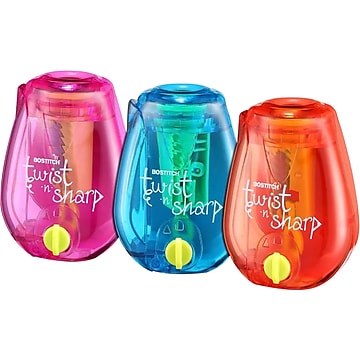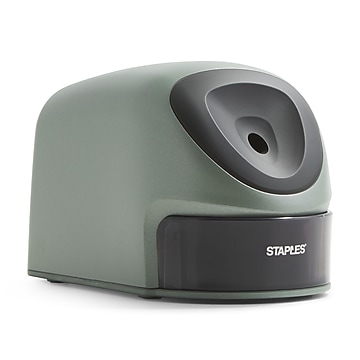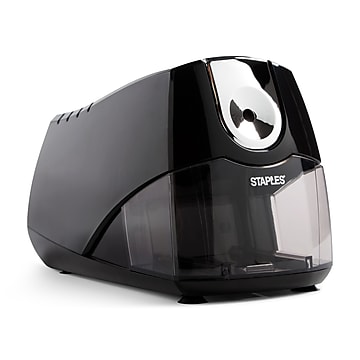Pencil Sharpeners
Best Match
Grid view
Pick up and Delivery
Brand
Pencil Sharpener Type
Pencil Sharpener Mount Type
Pencil Sharpener Selector Dial
Deals
Trending now
Price is $16.99, Regular price was $20.49, You save 17%
Unit of measure 100/Box Price per unit $0.17/File Folder
Delivery by Wed, Apr 23
1-hr pickup
1
1
2
3
4
5
6
7
8
9
10
11
12
13
14
15
16
17
18
19
20
21
22
23
24
25
26
27
28
29
30
Over 30


7% off of Staples QuickStrip EasyClose Self Seal Security Tinted #10 Business Envelopes, 4 1/8" x 9 1/2", White, 500/Box (ST50312-CC)
Price is $25.99, Regular price was $27.99, You save 7%
Unit of measure 500/Box Price per unit $0.05/Envelope
Delivery by Wed, Apr 23
1-hr pickup
1
1
2
3
4
5
6
7
8
9
10
11
12
13
14
15
16
17
18
19
20
21
22
23
24
25
26
27
28
29
30
Over 30
The first pencil sharpener was created in 1828, and after being perfected and made commercially available in 1940, these devices quickly became a staple in offices, homes, and schools. With so many different styles to choose from, getting the right sharpener is easy. Staples has a selection of office supplies and pencil sharpeners from well-known brands to give you the pencil point you want.
What to Look for in a Pencil Sharpener
All pencil sharpeners work differently and sharpen different sized pencils. The size of the pencil diameter determines the type of sharpener needed. Most sharpeners accommodate an 8-millimeter pencil, the standard pencil diameter. Larger pencil sharpeners work for pencils up to 10.5 millimeters in diameter. Sharpeners also handle different shapes of pencils, including triangular, hexagonal or circular. The sharpening angle can vary, as can the gentleness of the blade. The sharpening cleanliness may also vary, depending on the blade and size of the sharpener.
Choosing a Pencil Sharpener
When you select a pencil sharpener, keep in mind the sharpening angle you want. A larger angle cuts more of the wood away, giving the pencil a longer lead tip. A shorter angle produces a smaller, more durable tip. The lead point also varies, so look for a sharpener that creates either a sharp or blunt tip, depending on your preference. If you have large pencils, like children's over-sized pencils, then choose a sharpener with at least two diameter options. Some sharpeners have 10 or more options with a panel you can rotate to get the closest fit. The correct diameter helps hold the pencil in place while it's being sharpened. Cleanliness may matter to you, and if so, choose a sharpener that doesn't leave graphite marks behind on the wood. Some lower-quality sharpeners also leave behind residue that gets stuck on the blade.
What Kinds of Pencil Sharpeners Are There?
Common, basic sharpeners have one 8 millimeter opening and a single blade. These usually have razor blades inside, which are guarded with plastic or metal casings. The hole is conical, producing the pointed lead tip. Planetary sharpeners mount to a desk or wall and have a crank that turns a rotating blade or grinder. Some models of pencil sharpeners allow the pencil to twist back and forth instead of rotating it 360 degrees to achieve the right sharpness. The blade inside actually moves with you as you sharpen the pencil to prevent wrist fatigue. Long-point sharpeners produce long, super-sharp points. Whichever kind you are looking for, pencil sharpeners are a great addition to any school supplies list.
Which Is Better: Electric or Manual Pencil Sharpeners?
Electric pencil sharpeners sharpen colored pencils when they are pressed inside the sharpener's hole. It recognizes the presence of the pencil and switches on, quickly rotating its blades to sharpen the pencil. Electric sharpeners make it easy for children to get good points on their pencils or crayons. If many pencils have to be sharpened, an electric sharpener does most of the work for you. Manual pencil sharpeners don't have power, so you twist the pencil to get the blade to cut the lead. This allows for better precision, and you can angle the pencil to sharpen just the tip or continue sharpening it until the entire top has the shape you desire. Pencil sharpeners do not work with mechanical pencils.
What to Look for in a Pencil Sharpener
All pencil sharpeners work differently and sharpen different sized pencils. The size of the pencil diameter determines the type of sharpener needed. Most sharpeners accommodate an 8-millimeter pencil, the standard pencil diameter. Larger pencil sharpeners work for pencils up to 10.5 millimeters in diameter. Sharpeners also handle different shapes of pencils, including triangular, hexagonal or circular. The sharpening angle can vary, as can the gentleness of the blade. The sharpening cleanliness may also vary, depending on the blade and size of the sharpener.
Choosing a Pencil Sharpener
When you select a pencil sharpener, keep in mind the sharpening angle you want. A larger angle cuts more of the wood away, giving the pencil a longer lead tip. A shorter angle produces a smaller, more durable tip. The lead point also varies, so look for a sharpener that creates either a sharp or blunt tip, depending on your preference. If you have large pencils, like children's over-sized pencils, then choose a sharpener with at least two diameter options. Some sharpeners have 10 or more options with a panel you can rotate to get the closest fit. The correct diameter helps hold the pencil in place while it's being sharpened. Cleanliness may matter to you, and if so, choose a sharpener that doesn't leave graphite marks behind on the wood. Some lower-quality sharpeners also leave behind residue that gets stuck on the blade.
What Kinds of Pencil Sharpeners Are There?
Common, basic sharpeners have one 8 millimeter opening and a single blade. These usually have razor blades inside, which are guarded with plastic or metal casings. The hole is conical, producing the pointed lead tip. Planetary sharpeners mount to a desk or wall and have a crank that turns a rotating blade or grinder. Some models of pencil sharpeners allow the pencil to twist back and forth instead of rotating it 360 degrees to achieve the right sharpness. The blade inside actually moves with you as you sharpen the pencil to prevent wrist fatigue. Long-point sharpeners produce long, super-sharp points. Whichever kind you are looking for, pencil sharpeners are a great addition to any school supplies list.
Which Is Better: Electric or Manual Pencil Sharpeners?
Electric pencil sharpeners sharpen colored pencils when they are pressed inside the sharpener's hole. It recognizes the presence of the pencil and switches on, quickly rotating its blades to sharpen the pencil. Electric sharpeners make it easy for children to get good points on their pencils or crayons. If many pencils have to be sharpened, an electric sharpener does most of the work for you. Manual pencil sharpeners don't have power, so you twist the pencil to get the blade to cut the lead. This allows for better precision, and you can angle the pencil to sharpen just the tip or continue sharpening it until the entire top has the shape you desire. Pencil sharpeners do not work with mechanical pencils.


![Staedtler Pencil And Crayon Sharpener Double Sharpener [Pack Of 4] (4PK-512 300SBK)](https://www.staples-3p.com/s7/is/image/Staples/m004540706_sc7?wid=360&hei=360)




![Kum Ellipse Ice Pencil Sharpners 1 Hole Pencil Sharpener [Pack Of 8] (8PK-303.33.21)](https://www.staples-3p.com/s7/is/image/Staples/m004538765_sc7?wid=360&hei=360)








































































